Medical animation and illustration has been a large field of computer graphics for many years in the US and in recent years has gone through a boom period the UK with new studios starting up. With a wide variety of clients and an increased interest in health amongst the public this field is expanding at the moment and offers a broad range of work for CG artists with an interest in science. Medi-Mation is a London-based studio that’s been running since 2006 and in that time has worked on many interesting projects such as healthcare awareness illustrations, books, iPad apps and TV shows. Founder and owner Rajeev Doshi is an animator who comes from a biomedical background. We asked him a few questions about medical animation and the projects at Medi-Mation, what it takes to become a scientific animator and some of the challenges he’s faced when starting his own studio in this area.
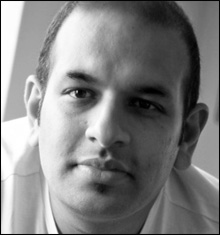
You come from an interesting background so can you tell us what led you to computer graphics and how you got started initially?
I have always been a bit artistic but back in years gone by, it didn’t seem a viable career route so my parents pushed me more towards science which I loved as well and hence I followed that route through to completing a PhD researching new therapies for cancer! Whilst working on my thesis, I started playing with the 3D software that was freely available back then (Bryce), making ‘interesting’ imagery for presentation slides. The positive responses I got made me really interested in the process of creating 3D imagery but I didn’t have any obvious routes to follow to further my knowledge in a formal way…but then I got my first lucky break…
A friend of mine told me about someone who was starting an 3D animation training studio in New York and advised me to get in touch with him…to cut a long story short I ended up handing in my notice (as a Postdoctoral Research Fellow) and went to New York for 4 months to train in 3D Studio Max. Since it was a make or break thing for me I really made sure it was an intense learning experience so I probably learnt more than 4 months might suggest.
Upon finishing, I came back to the UK and tried to look for work where I might be able to fuse my knowledge and interest in science with my new found 3D skills….it was a tough 6 months….! I almost gave up but I managed to get a freelance project creating 3D illustrations (and subsequently animations) for some educational science DVD-ROMs and that kept my busy for a year. Then came my next and biggest lucky break….
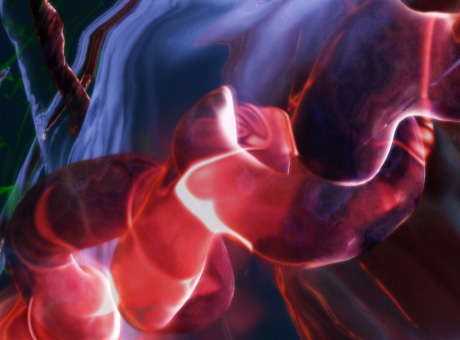
I met the creative director at a medical agency about a job which I wasn’t actually qualified for but we got talking and the idea of setting up a medical animation department at the agency was born and that’s how it all really started for me. It was a slow start but over the years it grew in size and I ultimately became the Digital Media Department director there.
How did Medi-Mation begin? Can you tell us a bit about the studio and how you’ve progressed?
After running the Digital Media Department for 5 or so years, I had ended up more managerial and less hands on which I really began to miss. The work was also becoming more run of the mill and samey so I thought it would be brave but worthwhile decision to go it alone and see what else was out there.
So in 2006 I started Medi-Mation and immediately picked up a very interesting project creating the 3D illustrations and animations for a new anatomy book (with DVD-ROM) for Dorling Kindersley, it ultimately become one of their biggest ever selling adult reference titles in the US and the rest is history 😉
Certainly that title helped forge our reputation and led to the opening of many doors and enquiries. We now work with a huge range of clients including pharmaceutical companies, healthcare agencies, museums, publishers, television production companies, doctors and other blue chip companies. It’s really this range of clients and the variety of work we do which keeps us interested and excited and makes the decision to start Medi-Mation one of my best!
In terms of projects we have done; books, 360 degree immersive projection animations, Stereoscopic 3D animations, TV shows, iPad apps, healthcare awareness illustrations and videos, promotional animations, illustrations for fitness training, newspaper and magazine editorial illustrations and pretty much anything where we can use the types of visuals we produce.
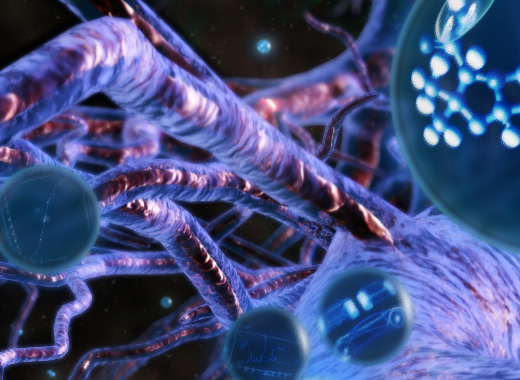
What’s the most difficult part about starting your own studio?
We were very lucky in that we picked up the big 8 month project straight away which allowed that ever important cashflow to begin and made us ‘learn the ropes’ of running a studio on the fly which is often the best way…though not the most organised. Now on a day to day it’s more about keeping a balance of looking for new projects, managing and working on existing ones, PR, marketing, training etc.
Running the company certainly keeps me hands on everything which I really love – though there really aren’t enough hours in the day! Luckily the team who deal with the nuts and bolts of getting projects completed are all brilliant and rarely cause me any headaches or sleepless nights!
What kind of software do you use and what’s the most important software requirement for you?
For the bulk of our work, our core application is 3D Studio Max but now ZBrush has firmly established itself in our pipeline for model building and texturing. We use Brazil r/s for rendering and Combustion and After Effects for compositing work.
At this point in the evolution of 3D software they pretty much all do what you want to do and really new features can speed things up but are often not applicable to all markets and industries.
So for us we just like software that is stable and quick, that’s why we often end up using version that may be a couple of iterations old just so we know they have all been patched and are stable in a studio workflow.
It’s rare we hear about the next big feature and have to upgrade for that. Saying that – the huge leapfrogs in ZBrush’s feature sets with each iteration do make that one particular software where regular updates are worthwhile!
How important is post-production for your work?
Post-production is an absolute requirement – I believe that no render should ever be classed as complete straight from the 3D software. Even if it’s simple colour correction work, every single render will benefit from some post-work. I’m not sure that’s what people like to hear but I think it’s rarely worth the extra time needed to make the perfect render in the 3D application…export passes, give yourself options in the compositing software (be it Photoshop or After Effects), you’ll thank yourself later!
Maybe that’s the business owner speaking as well since time is money unfortunately, and your working attitude is certainly different than if you are doing a personal project where time may be less of a limiting resource.
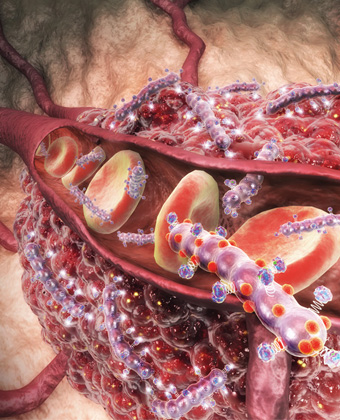
What’s the market like for medical animation in the UK and has the poor financial climate had an effect on you?
From our point of view, the market is good and growing. It’s not at the level of the US yet (though about a third of our work is for US companies) but with all the interesting opportunities that present themselves here I’m very happy it’s going the right way.
There was a period in late 2011 where I thought things might be starting to get affected by the poor financial climate but that seems to have been a temporary blip and 2012 is once again firing on full cylinders.
With health being such a important issue and people wanting to learn more whilst also having a greater baseline knowledge in the first place – there are always going to be more and more opportunities and outlets for medical animation and illustration (which should not be forgotten as it’s about 40-50% of our business as well).
As a scientist yourself, do you think computer graphics play an important part in providing learning tools that weren’t available for students of natural sciences a few years back?
That’s certainly the case though often I find that a good old book is still a great way to learn. But yes it’s true there are many things which are easier to understand when shown an animation or something that can be interactive. Human beings are visual by nature so all these learning tools provide great additional learning avenues for people.
It would appear that the trend in the future will be digital and portable for learning so yes, computer graphics-based tools will certainly be a key resource for learning going forwards.
What’s the typical pipeline for a project at your studio?
Our animation pipeline is very much standardised with that used in film and television work; our client will approach us with an idea which may be well formed or just at an early gestational stage.
Depending on that we start an initial dialogue about what their key messages need to be, aesthetics and budgetary constraints (or not! Yes, we’ve had one of those!). Which ultimately ends up producing some sort of brief from the client and quote from us. From here we will work with the client to develop the idea into an animation outline which then usually moves to a visual storyboard which we create (though some clients will come to us at this stage with boards already developed…it can make quite a nice chance since it forces you to look at a project with fresh eyes and their art directors will often approach things in a different way to how you might yourself which is great).
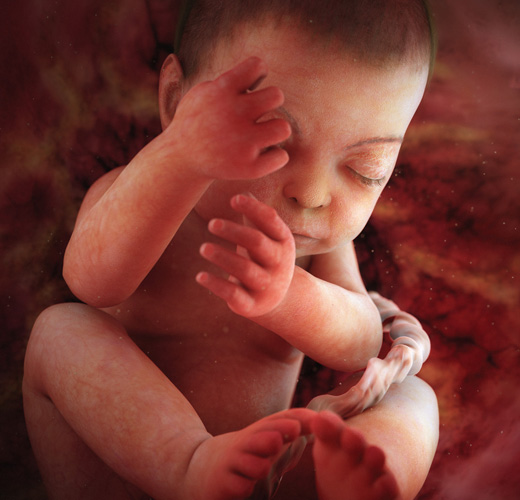
Once approved (with a few rounds of amends and tweaks), we will start to develop the key digital assets such as drug molecules, cell types, environments, anatomy, medical devices etc which all get approved before we move to pre-visualisation. Alongside this we often create mood/style boards that show frames from animations we or other companies have done and which allow the client to give us an idea about the look and feel they are hoping to instil in the animation.
We always create a pre-vis which is a full edit of the animation but often with simple models and no textures or lighting – usually with a temp voiceover which we record in-house. This is useful for both us and the client since it allows them to see and check everything is being shown correctly scientifically but also that any key messages are clearly relayed and that the story has good pacing and flow. For us it allows us to see if there are going to be any issues with shot editing or flow – sometimes the edit can be juggled around to make more sense and to have additional impact and by working this out at the pre-vis stage, we can make any tweaks to the animation here before committing to final renders. Alongside the previs we will take key shots and create initial composite frames which are textured, lit and composited so the client can see/comment on the look of the shots before we render finals.
From there it’s rendering and post-production (compositing, editing, sound/music/voiceover) then delivery.
In terms of referencing in addition to that which the client provides, we just watch a lot of material and it’s all in our heads so sometimes we think’ oh yeah this shot would be great if it was like that shot in that film’ etc. Apart from that Google, Science Photo Library and extensive library of books we’ve accumulated provide inspiration for us.
What’s the largest project you’ve worked on in your career so far?
It’s hard to say what the largest is since you can measure that in many ways; from the budget, development time (either longest or shortest…i.e. most stressful!) or complexity. I suppose one of the largest in terms of development time and volume of animation produced were the BUPA health factsheet animations we produced. Over a period of 16 months we produced over 65 animations with a typical run-time of 3-4 minutes each so looking at just under 4 hours of animation. Though they were not high-end animations in the sense of the post-production required, the size of the project meant we had to set-up a separate unit just to work on the animations with a tight ship required to turn over more than 4 per month!
It was a great project to work on since it helped tighten up our pipelines and we’ve now just been asked to produce more since they originals have gone down really well with the public.
In terms of the largest physically that would have to be the 360 degree immersive animations we did showing the differences in animal and plant cells – we ended up rendering 3600×3600 pixel frames with fish-eye lenses!
Do you need to have a scientific background and medical knowledge to become a medical animator?
It’s definitely NOT a pre-requisite to become a medical animator but you certainly have to have a strong interest in it. The reason being that students who have learnt traditional 3D animation often with a heavy emphasis on character work might find medical animation quite a straightjacket. Medical animation is still a great outlet for creativity but you’re often solving a very different set of problems from those you might face with character work some people love it but it’s not for everyone. In many ways it’s probably more technical in many aspects but you can have a lot of fun when it comes to creating cool looking environments or realistic anatomy etc….there is probably a lot of variety with this type of work – one second you could be looking at the external body the next zooming into a skin cell or into the blood stream.
In terms of learning what’s correct and what is not there are many conventions for how certain things are shown with medical work so once you know that it’s with you forever and then it’s often a case for working out how to stretch the visual representation of cells, molecules and anatomy in new and interesting ways to provide something fresh for the audience.
What do you look for in people when you hire medical animators at Medi-Mation? Do you have some advice for people who want to work in this field in the future?
It’s all about the ‘eye’ – people who know what looks good and what looks ‘right’ be it modelling, texturing, animation or composition – it’s often easy to spot the talent with both their own work and criticism of other people’s works. For me it’s not something that can necessarily be learnt but it’s more an innate understanding so when I see it I know it and I try to work with them!
We are not large enough to be able to separate out the modelling, animation and compositing tasks completely at this stage so it’s always good to find people who are generalists but with strong skills in one or more of the disciplines as you would often take a shot from conception to completion.
For those looking to work in this field – show your commitment to this type of work, knock out some quick clips for your reel that show you interest and understanding – something as simple as a blood flow can show me how talented you are just by the way it moves. Try to emulate the real world look at photos on the Science Photo Library for reference and see if you can instil some of that in your work.
What’s the most interesting part about working with medical animation for you personally?
Well for me it’s been that ability to fuse my 2 interests of science and art into a rewarding career path. It’s great to get feedback from clients and the public about our work and ultimately I think that’s the most rewarding part of what I do seeing how it can affect and interest other people.
I recently did a talk with Alice Roberts on the Complete Human Body Book that we created all the 3D artwork for, at the Cheltenham Science Festival and I got a real buzz out of that and from being asked so many interesting questions by the audience so hopefully that might be something I can do more of in the future.
The fact that it’s still a changing and developing area keeps me on my toes and it will be great to see how the visuals we create will be improved as technologies get more and more advanced and the people we hire and work with get more and more talented!
.